The Oldest and Most Reliable Stock Market Model
by Dr. Steve Sjuggerud
There are only two simple things you need to know about the markets. Understand and follow them, and you will become an infinitely more successful investor. You can ignore practically everything else, and you'll still know nearly everything you'll ever need to know.
These simple things you need to understand and apply are:
1.) THE TRUE WEALTH 1-2-3 STOCK MARKET MODEL, AND
2.) THE MOST IMPORTANT LAW OF LASTING WEALTH - "DON'T LOSE MONEY"
If you follow the 1-2-3 Stock Market Model, and you follow The Most Important Law of Lasting Wealth, I'm confident your investment results will improve immediately and dramatically.
I know this because it has improved the investment performance of even the best investors I know.
One of the best investors I know has made millions in the markets. His investment career spans 30 years, through bull and bear markets. He now lives next door to the Kennedy Compound (on the beach) in Palm Beach, Florida, just down the road from Donald Trump. About two years ago, I told him the secrets that I am about to tell you. He now says these are the most important factors of his trading - by far. Today, in Palm Beach, he goes door-to-door telling his neighbors about these secrets, as they look to him for investment advice. This friend thanked me for saving him piles of money in the high tech crash of early 2002 by following these simple secrets.
Even better, by following these simple secrets, you won't fill your head up with worry - concerned about what they're talking about on CNBC, what your friends are saying, and all the other things that ultimately have no positive impact on your investment success. You'll know what really matters. And you'll know all that talk is just that - talk.
So without further ado, let's get started with the first thing you need to understand - The True Wealth 1-2-3 Stock Market Model.
SECTION 1:
THE TRUE WEALTH 1-2-3 STOCK MARKET MODEL
Green light - buy. Red light - sell. Yellow light - hold.
If you can understand traffic signals, you can invest with this model.
When I created the 1-2-3 Stock Market model, I wanted to design something that was easy to understand, reflected the most important things affecting stock prices, and would consistently make money in all market conditions
Since it's proven itself over history and has been very well received by both novice and sophisticated readers, I think I've achieved my goals. Let me share it with you. . .
Some time ago, I sat down and thought about what the most important factors are that affect the stock market. While an infinite number of factors are affecting the markets at any given time, there are three things that are always affecting the market. And I built a simple "traffic light" model based on whether these three things are working for you or against you.
The model tells you this... If all three of these things are in your favor, I say we're under a "green light." Time to buy. Under green light conditions (which have occurred 26% of the time since 1927), stocks have risen 19.5% a year.
If two out of the three factors are in your favor, it's a yellow light. This has occurred 50% of the time, and stocks have returned 10.7% a year under yellow light conditions.
And if two out of the three factors are AGAINST you, it's a red light. Time to sell. Stocks have lost 9.7% a year under red light conditions.
If you had been armed with this knowledge, you would have known that the market was under red light conditions beginning in early 2000. The stock market collapse would have come as no surprise to you.
So what are these three factors? I've learned it's best to phrase them in the form of questions. The following are the three most important questions to answer about the stock market:
A.) IS THE STOCK MARKET EXPENSIVE?
B.) ARE THE FEDS IN THE WAY?
C.) IS THE MARKET ACTING BADLY?
The answers to these questions cover nearly all the bases that affect the markets. So let's look at each question closely:
FIRST, IS THE MARKET TOO EXPENSIVE?
How do we define expensive? Well, the clearest, time-tested measure of whether stocks are cheap or expensive, is the Price-to-earnings (PIE) ratio.
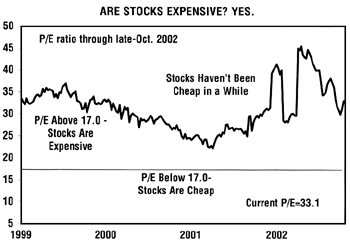
If you're not already comfortable with what the PIE ratio tells you, the best analogy I can think of is a house. If the PRICE of a house you're considering is $100,000, and you're confident you can EARN $10,000 a year in rent after expenses, that house is "selling" at a "PRICE-to-EARNINGS ratio of 10. (10x$l0,000=$100,000)
If you could earn $10,000 a year on a $50,000 house, that would probably be a good deal (either that or something is seriously wrong with the house). This is because the house would be paid for in five years, and all the earnings after that would be gravy. A house with a $50,000 price that earns $10,000 a year in rent is at a "price-to-earnings" ratio of 5. Clearly, paying 5 times earnings is better than paying 10.
However, paying a million dollars or more for this house, which would mean you're paying over 1 00 times earnings, would most likely not be a good deal. So it's interesting to note that the entire Nasdaq index was trading at a PIE of over 100 for a long time.
The same logic applies to the stock market.
From 1927 until mid 2002, if you'd bought stocks when the P/E was above 17.0 (when stocks were expensive), you would have made only 0.3% a year. The P/E was above 17.0 about 36% of the time.
However if you'd bought when the P/E was below 17.0, which occurred 64% of the time, you would have made 12.4% a year in stocks. Buy and hold would have made you 8.03%.
Right now, as I write this in 2002, the P/E is significantly above 17.0 - the market is expensive.
SECOND, ARE THE FEDS IN THE WAY?
Interest rates are probably the major factor affecting stock prices. Think about this for a moment... if the bank starts paying 12% interest, what would people do? Chances are, they'd move money out of the stock market and into the bank. Why take risks with stocks when you can get the same returns with much less risk? So it only makes sense that as interest rates rise, people sell stocks.
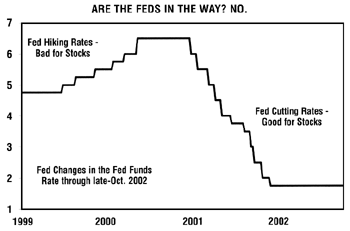
But there's more to it than that...
Let's take the flip side... As interest rates fall, people take their money out of the bank, and bonds, and whatever else, to seek higher returns. Those funds usually end up in the stock market. Additionally, as interest rates fall, companies can take on projects with lower profit margins that wouldn't have been profitable under higher interest rates.
This is the natural push and pull of markets.
The interest rate movements that have had the most dramatic effects on the market have been changes in the interest rates set by the Federal Reserve - in particular, the Fed Funds rate. When the Fed is raising interest rates - look out!
Seventy-one percent of the time, the Feds are not in our way - they're not in the midst of raising rates. And when they stay out of the way, we earn 10.9% a year in stocks, versus the buy and hold return of 7.9%.
However, for the 29% of the time the Feds are in the way, it pays to be cautious. Stocks only returned 1.0% a year with the Feds in the way.
How do we define the 29% of the time the Feds are in the way? It's simple. It's the six-month period following a hike in the Fed Funds rate. The Feds are out of the way either 1) after the six-month period has ended or 2) if the Fed cuts rates before the six-month period has ended.
Right now, as I write, the Feds are not in the way.
THIRD, IS THE MARKET GOING UP?
Market action is critical. The market knows more than anyone can predict. No market model is complete without some indicator of market action.
Sixty-seven percent of the time, the market is strengthening, based on our simple market action indicator. If you are in the market when this indicator says the market is strong, stocks have returned 12.6% a year.
Thirty-three percent of the time, the market is weakening, based on this indicator. If you are in the market when the indicator says the market is weak, stocks have lost 1.6% a year.
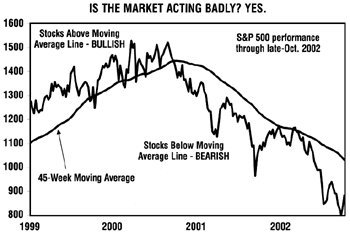
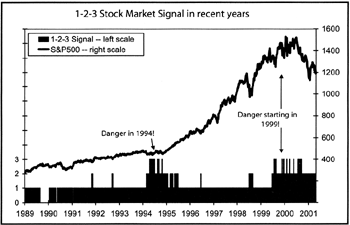
The market momentum indicator is simple: It's the 45-week average of stock prices. If the market is above its 45-week average, stock prices are strong. If the market is below its 45-week average, stock prices are weak.
Right now, the market is weak. The index is below its 45-week average.
Though I literally follow hundreds of indicators, all of them can basically fit into these three simple categories. If you know the answers to just these three questions, you will know whether you should buy, sell, or hold.
SECTION 2:
DON'T LOSE MONEY: THE MOST IMPORTANT LAW OF LASTING WEALTH
Let's face it - most people don't know when to sell a falling stock. So they're frozen into inactivity, saying "Should I just keep holding and hoping, or should I cut my losses now?" This state of indecision is usually permanent, and often continues until you hear the all too familiar phrase "well, it's too late to sell now."
One of my good friends lost it all following the "it's too late to sell now" principle. He bought a ton of shares of a cable stock based on his friend's recommendation. The shares soon tumbled in half, and his friend, who knows about the cable business, told him to buy more, so he did. The shares tumbled in half again, and he bought even more. He finally stopped buying when the shares hit a dollar a share. Now the shares trade for pennies - he would have to pay more in commissions than those shares are worth. He was uncertain about everything, and pretty soon it was all over.
After you've read this section and, if you follow the advice here, your constant state of indecision will be gone. You'll never lose another night's sleep worrying about which way your investments will go tomorrow. Because, unlike most investors, you'll have a plan - knowing when to get out, and when to stay in for the biggest possible profits.
Buying stocks is easy. There are thousands of theories out there for why and when to buy. But buying is only the first half of the equation when it comes to making money.
Nobody ever talks about the hard part - knowing when to sell.
We've all made expensive mistakes - either missing the full upside by selling too soon or taking a huge loss by holding a falling stock too long. But it's time to make big losses a thing of the past.
In order to invest successfully, you need to put as much thought into planning your exit strategy as you put into the research that motivates you to buy the investment in the first place. So please read closely here, and think about each point. . .
HOW DO YOU EVALUATE BUSINESSES?
In business and in stocks, you've got to have a plan and an exit strategy. When you have one, you know in advance exactly when you're going to buy and sell. The strategy I'll show you will allow you to ride your winners all the way up, while minimizing the damage your losers can do. Before I get into the specific strategy, consider this business example...
Let's say you're in the tee-shirt business. You've made a ton of money on your tee-shirt business in the States, and you're now in the Bahamas looking for new opportunities. You size up the market, and you figure you can make money in two places: in golf shirts, geared at the businessman, and in muscle-tees, geared toward the vacationing beach-goers. These are two products clearly aimed at two different markets.
You invest $100,000 in each of these businesses. At the end of the first year, your golf shirts are already showing a profit of $20,000. But the muscle-tees haven't caught on yet, and you've got a loss of $20,000. There are numerous reasons why this is possible, so you make some changes in your designs and marketing and continue for another year.
In the second year the same thing happens - you make another $20,000 on your golf shirts, and you lose another $20,000 on your muscle-tees. After two years, the golf shirts business is clearly a succeeding business, and the muscle shirts is clearly failing.
Now let's say you're ready to invest another $100,000 in one of these businesses. Which one business do you put your money into? The answer should be obvious. You, as a business owner, put more money toward your successful businesses. But as you'll see, this is the opposite of what 99% of individual investors in America do...
HOW DO YOU EVALUATE STOCKS?
Let me start by asking you a question - what does "owning shares of stock" actually mean? This isn't a trick question. As you know, it means you're a partial owner of the company, just like you're the owner of the tee-shirt company in my example.
Owning your own business isn't fundamentally any different than owning a share of a business through stock. However, 99% of investors treat them exactly the opposite...
Let's say the shares of your two tee-shirt companies trade on the stock exchange.
They both start trading at $10 a share. At the end of the first year, the profitable golf-shirt company is trading for $12 a share, and the unprofitable muscle-shirt company is trading for $8 a share. At the end of the second year, the golf shirt company is trading at $14, while the muscle shirt company is trading at $6 a share.
Which shares would you rather own?
Even though you know you should buy the winning concept based on the business example, most investors don't do so in their stock investments. They keep throwing good money after bad hoping for a turnaround. They buy the "cheap" stock - the loser.
THE TRAILING STOP STRATEGY
In stocks (and in business, I believe), you must have and use an exit strategy - one that makes you methodically cut your losses and let your winners ride. If you follow this rule, you have the best chance of outperforming the markets. If you don't, your retirement is in trouble.
The exit strategy I advocate is simple. I ride my stocks as high as I can, but if they head for a crash, I have my exit strategy in place to protect me from damage. Though I have many levels of defense and many reasons I could sell a stock, if my reasons don't appear before the crash, the Trailing Stop Strategy is my last ditch measure to save my hard-earned dollars. And it works.
The main element to the Trailing Stop Strategy is a 25% rule. I will sell any and all positions at 25% off their highs. For example, if! buy a stock at $50, and it rises to $100, when do I sell it? If it closes below $75 - no matter what.
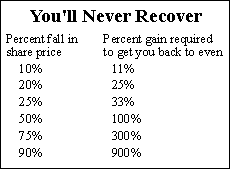
DON'T LET YOUR LOSERS BECOME BIG LOSERS
So with my Trailing Stop Strategy, when would I have gotten out of the failing muscle-shirt business? You already know the answer. Remember the shares started at $10 and fell immediately. Instead of waiting around until they fell to $6 as the business faltered, using my 25% Trailing Stop, I would have sold out at $7.50. And think of it this way - if the shares fall to $8, you're only asking for a 25% gain to get back to where they started. But if the shares fell to $5, you're asking for a dog of a stock to rise 100%. This only happens once in a blue moon - not good odds!
So what's so magical about the 25% number? Nothing in particular - it's the discipline that matters. Many professional traders actually use much tighter stops - the Investor's Business Daily newspaper, for example, recommends an 8% stop. Ultimately, the point is that you never want to be in the position where a stock has fallen by 50% or more. This means that stock has to rise by 100% or more just to get you back to where it was when you bought it. By using this Trailing Stop Strategy, chances are you'll never be in this position again.
USE DAILY CLOSING PRICES
I use end-of-day prices for all my calculations, not intraday prices. You should too. This makes things easier. If a stock has gone to $100, put at least a mental stop at $75. If, subsequently, the stock closes at or below that $75 level, sell your shares the next day.
I have to admit, it took me three years to truly follow my own advice on this one. I would always come up with some excuse for why I should keep holding some dud stocks. Nearly every time with those losers, if I'd practiced what I preached, I'd have been better off.
Now I always cut my losses. And once you get into the habit, and commit to doing it, it is not hard.
One thing in life is certain: That the future is uncertain. Nobody - not even the most astute analyst or investment advisor - can know enough about a particular company, industry or the nuances of the market, to anticipate with 100% certainty future price.
But common sense dictates two fundamentals: 1) taking small losses is much better than taking big losses and 2) letting your profits run is much better than cutting them off prematurely.
By following this simple plan accordingly, I strongly believe your investment results will start to improve immediately and dramatically.




